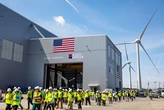A robot that folds your laundry is the kind of idea that sells itself. Just ask Syncere, a five-person startup that secured more than 1,000 preorders for its Lume robot with nothing but a simulated concept video.
That video, which racked up more than four million views on X over the summer, shows a pair of bedside lamps transforming into robotic arms that calmly fold a pile of laundry on the bed. (The video itself does not acknowledge that it’s a computer-generated rendering.) Syncere is taking preorders for $200—or $2,000 to be first in line—with plans to launch next summer.
Introducing Lume, the robotic lamp.The first robot designed to fit naturally into your home and help with chores, starting with laundry folding.If you’re looking for help and want to avoid the privacy and safety concerns of humanoids in your home, pre-order now. pic.twitter.com/2JmU0qXUIV— Aaron Tan (@aaronistan) July 28, 2025
Introducing Lume, the robotic lamp.The first robot designed to fit naturally into your home and help with chores, starting with laundry folding.If you’re looking for help and want to avoid the privacy and safety concerns of humanoids in your home, pre-order now. pic.twitter.com/2JmU0qXUIV
“The idea is that you just dump your laundry on the bed and then you walk away . . . and when you come back, it’s as if the laundry on the bed magically folded and sorted itself,” CEO Aaron Tan tells Fast Company.
Automating housework has been a dream going back at least as far the invention of the dishwasher and its 1893 debut. Although most of the current robot revolution has focused on the workplace and the prospect of working side-by-side with a humanoid, the response to Syncere’s video and that of Figure’s humanoid folding towels last month has shown there’s a lot of interest in domestic robots that could take over tedious chores most people hate.
And laundry’s got to be at or near the top of that list.
In this Premium piece, you’ll learn:
- How Syncere came up with the concept of robot arms that double as lamps
- The key technologies that Tan says enable robotic laundry-folding to be possible
- What happened to the buzzy laundry-folding bots of the 2010s
- Which training data and techniques Syncere is relying on to teach its robot how to fluff and fold
- The hurdles the startup faces to realize its vision
From bot-of-all-trades to clothes horse
Syncere didn’t start out with laundry-folding robots in mind.
Having earned PhDs in robotics from University of Toronto, Tan and co-founder Angus Fung originally designed a mobile robot with an arm to perform a variety of tasks, from cleaning and bed-making to food delivery. To test their ideas, they found work as housekeepers at a Marriott in the Toronto area, aided by a manager who was willing to let them experiment.
But when they started bringing their robots into people’s homes for testing, they started getting pushback. The idea of installing an industrial-size robot in the home didn’t sit well with people, who either feared for their safety or weren’t sure where they’d put it.
“What people wanted was a way to get rid of their chores, but they want their homes looking beautiful, not having to worry about getting run over or colliding with these large machines,” Tan says.
That led to the idea of a robot that focused only on folding laundry and could fit more naturally into home environments. Syncere’s new plan calls for a pair of six-axis robot arms that stand about six feet tall, working as regular lamps when they’re not folding clothes. They’ll come equipped with cameras and a “board of similar specs” to Nvidia’s Jetson Orin developer kit (though Tan declines to name the specific processor), with data processed on-device. While folding times can vary, Tan claims that Syncere’s robot arms can fold a garment in as quickly as 5 to 10 seconds.
“We envision an average load of laundry to take less than two hours to do,” he says.
A history of unfulfilled promise
Syncere isn’t the first startup to build buzz by promising to eliminate one of the most tedious household chores.
In the late 2010s, a couple of rival startups called Foldimate and Seven Dreamers became fixtures at trade shows such as CES, showing off their ability to fold garments with little to no assistance. Foldimate promised a sub-$1,000 price tag, but required users to manually feed clothing into the machine, while Seven Dreamers’ Laundroid robot aimed to fold clothing autonomously in a $16,000 box the size of a large armoire.
Neither product made it to market. Foldimate’s website quietly went offline a few years ago without explanation, and the company behind Laundroid filed for bankruptcy in 2019 despite raising $100 million, with CEO Shin Sakane citing problems with mass production.
Reached via LinkedIn, Sakane said he still hopes to bring Laundroid to life in the future, but said he isn’t working on it now and didn’t respond to further requests for comment. Emails to an address believed to be associated with Foldimate founder Gal Rozov went unanswered, as did a request for comment with the company he now works for.
The AI eyes have it
Tan says the barriers to building a laundry folding robot are lower than they were five or 10 years ago. Robotic arms and actuators are cheaper and easier to acquire, but more importantly, AI and computer vision technologies are much more advanced.
“It quite simply comes down to the advances in AI,” Tan says. “The advances in computer vision that happened in the late 2010s and early 2020s, and most recently with these large foundation models . . . things are a lot different now.”
To start training its robot, for instance, Syncere used open-source vision-language-action models, a concept that Google pioneered in 2023 that allows robots to understand and take action on what they’re seeing. Syncere is also using large language models to help describe garments to the robot so it can understand what they are and how to treat them.
David Held, an associate professor at Carnegie Mellon University’s Robotics Institute, says recent advancements such as vision-language-action models only provide a starting point.
Syncere would still have to train the robot to do the actual folding, and that’s going to take a lot of time and effort.
Training the robot
Currently, one of the best ways to train this kind of robot is through teleoperation, or “puppetry” as Held calls it. Essentially, the trainer uses a remote control or joysticks to manipulate the robot’s arms and fold laundry manually. Through this process the robot eventually learns how to handle different types of clothing.
Tan confirmed that Syncere is using teleoperation to train its robot, but Held says that it’ll take a lot of data to account for things like crumpled up shirts or an inside-out pair of pants. It’s unclear how much data will be necessary to make a home robot work reliably.
“Companies that are working on this problem and trying to release this as a product are betting that they can collect enough data, and train a big enough network, to handle all of that variability,” Held says. “I think that’s a big unknown right now, whether that’s going to pan out, or whether we’re going to need other ways to augment that data.”
More obstacles ahead
Assuming Syncere can train its Lume robot to fold a pile of laundry from start to finish, a more pedestrian obstacle remains: It still needs to figure out how to manufacture at scale a product that’s never been made before. Even if laundry-folding robots are more feasible now, that doesn’t mean they’re easy to make. Previous laundry-folding robot startups have fizzled out before shipping a single unit, and Syncere has yet to show evidence of a working prototype.
For now, Syncere isn’t thinking much about it. Tan says the company plans to build every individual robot in-house for at least the first year. That won’t be sustainable for long, but he says the approach will allow the startup to “keep the iteration cycle tight” in conjunction with early backers. (Note that neither Tan nor his co-founder Tan have any prior experience shipping consumer hardware.)
In other words, those who put down $200 or $2,000 now are essentially signing up to be beta testers, a point that is not made clear on Syncere’s order pages.
Meanwhile, Syncere may need sources of funding beyond what it’s collected from 1,000-plus preorders, and its financing situation is unclear. Tan cited a16z as “one of our investors,” and its website refers to having “closed our funding round,” but it’s technically part of the a16z speedrun accelerator program, not one of its main portfolio companies. Syncere has also received funding from the incubator Founders, Inc and is working out of its San Francisco office.
Tan says Syncere plans to keep its early customers in the loop with a steady drip of content, including an eventual look at a prototype. Syncere led with a rendered concept video, he says, “because we wanted to paint the vision clearer.” But it’s worth remembering
That strategy has worked to an extent, in that Syncere has gradually raised its waitlist price from $50 to $200 off the success of its viral video. “We’ve slowly increased the price as we’ve exceeded our original expectations,” Tan says.
Now it just needs to meet the expectations of folks who’ve been hearing about laundry-folding robots for close to a decade now, only to have come up empty-handed.
With recent advancements in AI and computer vision, laundry-folding robots are more feasible than they’ve ever been. The question is whether Syncere will be the one to finally deliver them.










No comments